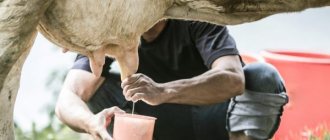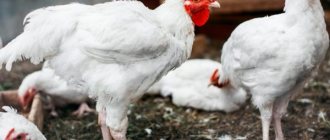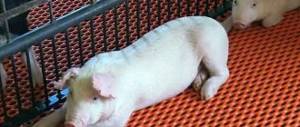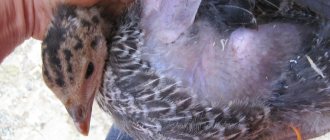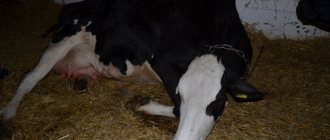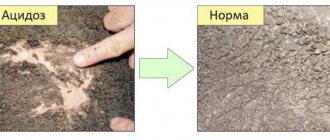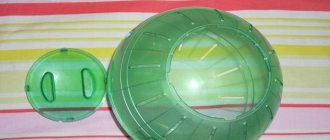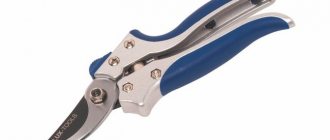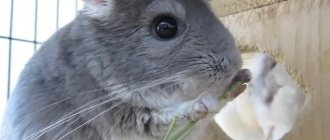Diseases of the sense organs
The organs most often affected by diseases in chinchillas are hearing, smell and vision. Discharge from the eyes, ears and nose can also indicate other diseases that occur in the animal's body. Let's list the diseases of chinchillas and their treatment at home.
As a result of damage to the cornea of a chinchilla's eye, keratitis may occur. Mechanical damage can occur through contact with water, as a result of swimming in the sand, or it can be caused by another animal. Main symptoms: redness of the mucous membrane, change in eye color, discharge of mucus and pus from the eye. Before treating an eye disease in a chinchilla, you should consult a veterinarian. The eye should be rinsed with furatsilin solution or plain clean warm water. All pus must be completely removed. Afterwards you can use eye drops. Apply eye drops three times a day. Eye ointments will restore transparency to the cornea.
Conjunctivitis is one of the most common eye diseases in chinchillas. Main symptoms: souring of the eyes, discharge of pus, tearing, loss of vision. Below is a photo of a chinchilla disease. The main causes of the disease are considered to be: infection from a sick animal, violation of living conditions, unsanitary conditions, lack of vitamin A in the diet. How to treat eye disease in a chinchilla? The sore eye should be washed with infusion of calendula or chamomile several times a day. If there is copious discharge of pus and severe inflammation, you should use Levomycetin or Garazon eye drops. In difficult cases, the doctor may prescribe antibiotics.
Otitis externa is characterized by inflammation of the chinchilla's outer ear. It can occur from hypothermia or due to improper conditions. The main symptoms of chinchilla disease: discharge of pus from the ear canal, scratching the ears with paws and on the cage bars, tilting the head to one side. First you need to remove the pus. Next, the ear is treated with zinc-containing ointment. In case of complications and to avoid the disease spreading to the second healthy ear, antibiotics should be used. During treatment, the chinchilla must be isolated from other animals in order to avoid infection.
Chinchilla runny nose treatment
The chinchilla has fairly good health. Most often, the cause of diseases in chinchillas is improper care or improper nutrition.
You can avoid the occurrence of diseases only if you carefully monitor the cleanliness of the cage, choose the right food and follow the animal’s diet.
But even all the precautions and good maintenance sometimes cannot eliminate the possibility of diseases one hundred percent. The appearance of the first health problems in a chinchilla can be noticed by the following signs: loss of appetite, unusual behavior, diarrhea, hard belly, weight loss, nasal discharge, redness of the skin, hair loss or baldness, discoloration of teeth, bad breath
As a rule, all these symptoms may indicate various diseases, but in most cases, chinchillas are more susceptible to gastrointestinal diseases, skin diseases, cardiovascular diseases, colds, dental diseases and diseases related to intimate hygiene
The appearance of the first health problems in a chinchilla can be noticed by the following signs: loss of appetite, unusual behavior, diarrhea, hard belly, weight loss, nasal discharge, redness of the skin, hair loss or baldness, discoloration of teeth, bad breath. As a rule, all these symptoms may indicate various diseases, but in most cases, chinchillas are more susceptible to gastrointestinal diseases, skin diseases, cardiovascular diseases, colds, dental diseases and diseases related to intimate hygiene.
Chinchilla diseases and their treatment
Diseases of the gastrointestinal tract in chinchillas
It is quite easy to recognize that an animal has stomach problems. The first signs are bloating, a hard stomach, diarrhea, flatulence or constipation. If at least one sign of problems with the gastrointestinal tract appears, it is better to contact a veterinarian. Only if it is impossible to see a doctor, you can try to help the pet yourself.
Chinchillas: health questions and answers (FAQ)
– The doctor prescribed antibiotics, how to give them to the chinchilla?
Antibiotics should not be given orally (i.e. by mouth) to chinchillas!
– What are the symptoms of a cold (pneumonia, etc.) in chinchillas?
The main ones: release of moisture (mucus) from the nose, less often from the eyes, later refusal of food and walks. Symptoms that the veterinarian will determine: wheezing, fever.
– What vitamins are best to give to chinchillas?
Complex vitamins for wool quality (“Fell glanz Saft”, Dr. Clauder's) 8-12 drops per daily water intake for a month.
“,Vitabon for rodents”, (“,Vita-Bon”, Vitakraft) half a tablet for a month, then take a break.
Complex vitamins for rodents (“Vitamin plus N”, Sera) 5-8 drops per daily water requirement.
– Do chinchillas eat vitamins on their own?
As a rule, if a chinchilla doesn’t eat vitamins, it doesn’t need it. If your chinchilla does not eat “solid” tablet vitamins, give her liquid vitamins in water to drink.
– How to accurately calculate the dose of Vakderm (antifungal vaccine)?
For prophylaxis (vaccination for preventive purposes) - a single injection of the drug intramuscularly (into the thigh) to adolescents 3-5 months weighing about 250-400 g, 0.2-03 ml. If the chinchilla is weakened, reduce the dose
Upward dose adjustments should be made carefully
For treatment, the injection must be done 3 times with an interval of 10 days, the dose is the same. After the first injection, deterioration may occur (and even certainly will occur), i.e. The area of bald areas may become larger.
This is because the vaccine is a weakened strain of fungi that is given to produce immunity. After the second injection, the process will slow down, and after the third, improvement will occur.
Most likely, all other chinchillas that come into contact with a sick animal will have to do all three injections, since even after 1-2 injections to a sick animal, it remains a carrier and is capable of infecting other rodents.
Dental problems
Dental diseases in chinchillas are quite common. For rodents, it is important that the incisors are in perfect condition, otherwise the animal will not be able to consume food. We list the main diseases of chinchillas and their treatment.
Misalignment of teeth is the main cause of malocclusion in chinchillas. This is most often a congenital pathology that is inherited. Due to malocclusion, the animal cannot eat solid food, the teeth do not grind down, and the problem gets worse. To correct the situation, the animal definitely needs the help of a specialist. Typically, a veterinarian will trim a chinchilla's incisors at a young age to correct the bite. Steroids may be used.
Sometimes a chinchilla's teeth can curl inward and form hooks. At the same time, the animal cannot eat food normally; it constantly rubs its muzzle. The chinchilla's appetite decreases and its weight decreases. Let's consider the treatment of chinchilla disease and photos of this pathology. In this case, the teeth need to be trimmed a little and fixed in the desired position. Only a veterinarian can handle this. Attempts to solve a problem at home can result in disastrous consequences.
A chinchilla's teeth should be red in color as adults. They can only be white in cubs. If teeth remain white even as you age, this may indicate a health problem. Often, a color change occurs due to a deficiency of phosphorus or potassium in the chinchillas’ body. If left untreated, teeth begin to decay and increased salivation occurs. The animal's appetite decreases and weight loss occurs. It is necessary to introduce the necessary microelements into the animal’s diet. They can be mixed with food. You need to put a vitamin-mineral stone in the cage, with which the chinchilla can grind down its teeth.
How to deal with hair loss in chinchillas
As soon as it is noticed that your pet’s hair is falling out rapidly, or bald patches have appeared on the body, you need to identify the probable causes and immediately begin to deal with it.
The set of measures aimed at preventing hair loss in animals includes:
- treatment with drugs prescribed by a veterinarian;
- elimination of factors that provoke an allergic reaction;
- introduction of fruits, vegetables and herbs to the nutrition menu;
- soldering the animal with vitamin and mineral supplements;
- improving the indoor microclimate;
- prevention and destruction of ectoparasites.
If you treat the animal carefully and start treatment on time, you can deal with the problem quickly.
Skin diseases
Chinchillas have very thick and soft fur, which is why they often have skin and coat problems. We list the main signs of chinchilla disease and methods of treating skin diseases.
If a chinchilla constantly scratches one place, it becomes bald, ulcers form on it, and infection with ringworm can be assumed. The areas most affected are around the tail, nose and ears. This is a highly contagious fungal disease that a chinchilla can catch through direct contact with another sick animal. For an accurate diagnosis, you must consult a doctor. Ringworm can be identified by shining a special lamp on the skin or taking a scraping. To treat it, the affected areas must be treated with Mycodermin ointment; it can be added to the sand for bathing. The cage and all its contents must be thoroughly disinfected. To avoid getting shingles, your chinchilla needs to be vaccinated. The drug "Vakderm" is injected into the femoral muscle. The vaccine is effective for a year.
A common problem for chinchillas is chewing their fur. The animal plucks its sides until it becomes bald. The exact reason for this behavior is unknown. It is assumed that the problem is a lack of fatty acids, as well as a low methionine content in the feed. Sometimes this happens as a result of severe stress. In this case, the cage should be placed in a quiet, dark place, and the chinchilla should be isolated from all sources of disturbance. If the animal stops chewing the fur, then the problem is solved. Otherwise, the proportion of methionine in the feed must be increased. You can give your animal small pieces of lard, but you just need to make sure that it doesn’t stain the fur. The cage should always contain a vitamin-mineral stone and hay.
Spot hair loss can occur as a result of violation of chinchilla maintenance standards. In this case, bald patches can be observed on the skin. You can help an animal only by correcting errors in maintenance. You should review the animal’s diet, perhaps change the sand for bathing, and analyze all the contents of the chinchilla’s home.
Quite often, through contact with other animals, chinchillas can become infected with fleas, ticks or lice. The chinchilla may begin to chew out its fur; it constantly itches and rubs against the bars of the cage. First, it is worth identifying the exact parasite from which the animal suffered. Depending on this, you need to start treatment. There are special collars for fleas and lice that are used for cats and dogs. The animal should also be treated with a special powder or spray. It is important to disinfect the cage to avoid re-infection. If your chinchilla is infested with mites, you may need professional help.
Reasons for refusing to eat
Some chinchillas are very picky eaters and may refuse to eat if the food is not fresh, monotonous, or the animal is not in the mood. Also, a furry pet may refuse the offered food in the hope of getting a more tasty treat. Animals often lose interest in food after experiencing stress. A new home, moving, visiting a veterinary clinic, or moving in with a new neighbor can cause stress. In this case, it is better to give your pet peace, talk to him kindly, and offer him his favorite treats.
However, in most cases, refusal to eat signals a health problem. The most common of them:
- Inflammation of the gastrointestinal tract (catarrhal),
- Heatstroke,
- Food poisoning,
- Problem with teeth
- Flatulence.
Catarrh
Catarrhal inflammation of the gastrointestinal tract can be of a cold nature, and also have an acidic or alkaline form.
Each form of the disease has some similar symptoms - refusal to eat, loose stools, accumulation of feces around the anus, lethargy. The cold form of the disease is characterized by yellowish feces; the chinchilla often sneezes and rubs its nose. With the acid form of inflammation, the chinchilla defecates very often, the feces have a sharp sour odor and are grayish in color. The alkaline form of inflammation is characterized by rare, but very loose stools that have an unpleasant smell of rot.
Treatment of the disease depends on the form of inflammation. Acid catarrh is treated with Syntomycin, which is given twice a day, 0.2 grams. A decoction of oak bark and a one percent tannin solution are also recommended. Alkaline catarrh is treated with drops of Salol, which are instilled into the animal’s mouth. A weak solution of ordinary potassium permanganate also helps. The cold form of the disease is treated with Biomycin. It is given twice a day, 0.2 g. It is also necessary to use nasal drops - one percent Furacilin or a 33% aqueous solution of Ecmonovocillin.
Any form of catarrhal inflammation requires a strict diet for the animal.
It is necessary to exclude everything except fresh and clean hay, as well as water. When the animal’s condition has returned to normal, they begin to give grated carrots, chopped oats and oat decoction. After this, regular feed is introduced.
Poisoning
Poisoning in a chinchilla can be caused by too salty food or toxic substances getting into the food. These include both poisonous herbs and various nitrates and other pesticides. Salt poisoning is characterized by refusal to eat, loud grinding of teeth, excessive salivation, severe thirst, and loose stools. The chinchilla becomes lethargic and refuses to make contact with its owner. Sometimes salt poisoning is accompanied by paralysis. Treatment for salt poisoning involves drinking milk or natural vegetable oil through a syringe. It is also necessary to administer 5% calcium chloride subcutaneously:
- For young individuals - one milliliter,
- Adults - three milliliters.
Poisoning can also occur as a result of eating poisonous grass or canopy, mold and rot along with hay.
Symptoms of poisoning vary depending on the amount of poison that enters the animal’s body. The most dangerous is severe poisoning, in which the chinchilla dies within two to three hours after feeding. Symptoms are severe diarrhea with a lot of blood, drooling, bloody discharge from the mouth, foam, refusal of food and water, convulsions, heavy and hoarse breathing. In case of acute poisoning, animals experience diarrhea or constipation (depending on the poison), bloating, the animal has poor coordination in space, and frequent convulsions appear. Poisoning can also be chronic. Symptoms are observed within one to two days:
- Refusal to eat
- Apathy,
- Pale mucous membranes,
- Loss of shine in fur
- The animal is rapidly losing weight.
For successful treatment, the source of the poison entering the chinchilla’s body must be determined. In the first hours after the onset of symptoms, it is recommended to give the animal strong emetics (Anamorphine) or laxatives, and also be sure to rinse the stomach. For washing, use ordinary warm water, in which crushed charcoal (you can use activated) charcoal is dissolved. Flax seed decoction, milk or any dairy products also help well.
Poisoning is always accompanied by severe dehydration, so it is necessary to monitor the constant presence of water in the drinking bowl.
If the pet does not drink, it is given artificially from a syringe every hour.
Dental diseases
Most often, a chinchilla does not eat due to dental problems. Hooked teeth or malocclusion is a common and common disease not only in chinchillas, but in all rodents. First symptoms:
- Poor appetite or refusal to eat,
- Fast weight loss,
- The animal chews each piece of food for a long time and thoroughly,
- Selects only the smallest and softest pieces,
- Profuse salivation
- Inflammation of the tissues of the lower jaw.
A more serious stage of the disease is accompanied by lethargy, copious discharge from the eyes and nose.
The cause of the problem is a genetic predisposition to improper placement of molars in the oral cavity. This leads to improper grinding of the molars - the rubbing surface as a result of such grinding comes into contact with the grinding surface of another tooth at an acute angle. Long and very sharp hooks form on the surface of the tooth, which injure the delicate mucous tissue of the cheeks, palate and tongue. This causes severe pain to the animal and makes it difficult to chew and swallow food.
When the disease is advanced, the pet loses more than ten percent of its weight, bowel movements become rare and are often in the form of very loose stools, the animal constantly rubs its muzzle and tries to get something out of its mouth, often yawns, and shows restlessness.
Treatment is carried out by removing or filing the hooks. If the disease is advanced, then the correction must be repeated every 4 - 5 months until the bite is completely restored. The procedure is carried out only in a veterinary clinic and under anesthesia.
Flatulence
Bloating in chinchillas usually occurs when too much green and juicy food is included in the diet. Green feed (especially legumes - clover and alfalfa) cause strong fermentation and gas formation. The disease is also accompanied by noisy and difficult breathing. Characteristic cramps are heard in the tummy. The pet becomes lethargic and refuses food and water. In more rare cases, flatulence leads to cramps. After convulsions, the chinchilla’s body temperature drops sharply to a dangerous 34.5 degrees. Young and weak animals may die at this moment.
Treatment of flatulence involves the use of adsorbent drugs:
- Espumisana,
- Carbolena,
- Activated carbon.
Magnesia and antibiotics have also proven themselves well: Etazol and Norsulfazol. They are given in 45 - 50 grams. You can also give Biomycin - about 20 grams. When treating flatulence, it is necessary to force the animal to move, since usually a sick chinchilla prefers to sit or even lie down. Movement is necessary to restore bowel function. A tummy massage, as well as an enema with warm and slightly soapy water, will also help.
On the first day after symptoms of the disease are detected, all hay and any remaining feed are removed from the feeders, leaving only water. On the second day, if the dynamics are positive, you can give the animal a little hay. On the third day - a little hay and granulated food.
Heatstroke
Keeping your pet improperly or living in a hot climate can lead to heat stroke. Overheating of the chinchilla's body is accompanied by:
- Lethargy,
- Refusal to eat
- The animal doesn't drink
- Breathing and heart rate increase,
- The mucous membranes become pale.
Severe overheating can also cause convulsions, animals fall on their sides and lose coordination of movement.
Severe heat stroke can cause the death of an animal.
First aid is to move the chinchilla to a cool, shaded place with good ventilation but no drafts. You can place a damp, cold towel on your head. If heat stroke causes convulsions, it is necessary to give an intramuscular injection with a caffeine solution - no more than two milliliters, and in case of heart problems, no more than two milliliters of twenty percent camphor oil and about twenty milliliters of a twenty percent solution of ordinary glucose are injected subcutaneously.
Respiratory diseases
The respiratory organs of a rodent often suffer due to improper living conditions for the chinchilla. Low room temperatures, drafts, dust, and infrequent cleaning of the cage can lead to colds and respiratory diseases. The main symptoms and signs of chinchilla disease:
- mucous and purulent discharge from the nose;
- hard breath;
- wheezing in the lungs and bronchi;
- dyspnea;
- apathy, decreased activity;
- lack of appetite.
A common problem for chinchillas is colds. Most often it occurs in spring and late autumn. The reason may be drafts or high dust levels in the room. The nose becomes wet and mucus streams from the nostrils. There may be white discharge in the corners of the eyes. For treatment, the animal must be given vitamin C. Leaking eyes should be washed with tea or a solution of boric acid. The animal can be given a solution of rosehip syrup.
If a chinchilla is kept in a stuffy, hot room, or if it inhales toxic gases, it may develop pulmonary congestion. The main symptoms of chinchilla disease: the animal is choking, coughing, its pulse accelerates, and bloody foam is released from the nose. First, the sick animal must be moved to a cool, dark place. The chinchilla is given a drip with a solution of glucose and calcium chloride. Caffeine or cordiamine can be used to support the heart muscle. If complications occur, antibiotics must be used.
The causative agent of infectious rhinitis is bacteria of different groups. This disease, if left untreated, can lead to the death of the animal. It manifests itself in the form of a runny nose and sneezing. The chinchilla rubs its nose with its paws and breathes quickly. If left untreated, wheezing may occur and body temperature may rise significantly. The animal needs to have inhalations. You need to drip a solution of penicillin or furatsilin into your nose. Antibiotics and drugs that support the immune system are also used.
Untreated colds can lead to bronchopneumonia. The main symptoms of chinchilla disease: convulsions, apathy and lack of appetite, severe cough, rapid breathing, wheezing. To treat bronchopneumonia, Biomycin should be used. The animal is given expectorants.
In small chinchillas that are born in the cold season, a common disease is pneumonia. The causative agents of infection can be staphylococcus and streptococcus. The main symptoms of chinchilla disease: mucus discharge from the nose, wheezing in the lungs, high body temperature. The doctor must prescribe the appropriate antibiotics for the chinchilla. A heating pad with warm water should be placed next to the animal.
How to understand that a chinchilla is sick
To understand that a chinchilla is sick, just take a closer look at your pet’s behavior. Healthy chinchillas have constant habits and habits. If the pet is healthy, then it:
- He has a good appetite, behaves calmly, and responds adequately to attention from people.
- Outwardly looks healthy - eyes are shiny and not damp; no growths or dirt on the ears and genitals; the fur is smooth, shiny and thick; nose is clean; the teeth are orange and straight.
- Eliminates round feces, does not lose weight (normal weight for chinchillas is 400-600 grams).
Thus, chinchilla diseases somewhat change their behavior. You can suspect something is wrong when your pet:
- Becomes lethargic, apathetic, may refuse to play and communicate, sleeps a lot.
- Refuses to eat and drink and may dig into food for a long time.
- Looks unhealthy - eyes are watery, wet and swollen; nasal discharge appears; corns and ulcers appear on the body, hair falls out and becomes greasy, etc.
- Sneezes, coughs, wheezes, constantly with his mouth open.
- He defecates with diarrhea and there is red discharge in his urine.
- He is rapidly losing weight.
- Possesses impaired coordination, convulsions and various seizures occur.
When such external symptoms appear, you should immediately contact a specialist to find out the reasons. This is important, because some chinchilla diseases can be transmitted to humans, and the cure will be a problem that will require time, effort and money to resolve. Among the diseases dangerous to humans are microsporia (chinchilla lichen), tuberculosis, rabies and others. They are dangerous for your pet, possibly fatal.
Problems with the reproductive system
Chinchillas do not often suffer from this type of problem. Most often, diseases of the reproductive system can occur in animals that are involved in breeding. We list the main diseases of chinchillas and their treatment.
Damage to the female's nipples can result in inflammation of the mammary gland. The main symptoms of chinchilla disease: blue or redness of the nipple and the skin around it, inflammation and swelling. There is a decrease in appetite and an increase in body temperature, and activity decreases. For treatment, penicillin is injected intramuscularly. The mammary glands need to be lubricated with healing and anti-inflammatory ointments. If there is a purulent abscess, it must be opened and all the pus removed, and the wound treated. This should be done by a doctor.
Penile prolapse most often occurs in males after mating with overly active or aggressive females. As a result, the genital organ becomes very swollen and the male cannot curl it. If everything is left as is, the male may well become infertile. Initially, you can apply a small cool compress to the penis to relieve inflammation. The genital organ must be lubricated with Vaseline or other antiseptic ointment, and then carefully set in place. After the incident, the male should not be allowed near the females for a week.
Quite often, males develop hair rings that do not allow the genital organ to open normally. This happens as a result of wool matting. The hair ring wraps around the penis like a rope. Such a male will feel severe discomfort and will not be able to mate with females. The owner is usually quite capable of removing the hair ring himself. To do this, you need to wear gloves. The penis must be treated with a disinfectant solution. The fur from the penis must be removed very carefully using tweezers. At the same time, you need to try not to damage the animal or aggravate the situation by tangling the hairs more. After the procedure, the penis will return to its place.
Pseudomonas microorganisms are causative agents of infectious diseases: endometritis, vaginitis, pyometra. Both males and females can carry the virus. Main symptoms: high body temperature, purulent and brown vaginal discharge, anxiety and aggression. When a female gets sick, the male is also treated, because he is also a carrier of the disease. After diagnosis, the doctor prescribes a course of broad-spectrum antibiotics.
Pododermatitis
When the skin on the soles of the paws is damaged, pathogenic bacteria can enter the wounds and cause inflammation. Signs of pododermatitis:
- severe itching;
- the animal bites its paws;
- anxiety;
- possible refusal of food;
- in the later stages, ulcers, calluses and corns appear.
Pododermatitis is relatively easy to treat, but treatment must be approached carefully. The wounds are washed with chlorhexidine 3-4 times a day and lubricated with antibiotic ointment.
Important! The animal must not be allowed to itch.
Gastrointestinal problems
Such problems are most often the result of improper and unbalanced nutrition of the rodent. Before purchasing a chinchilla, you need to thoroughly study the information regarding the rodent’s diet. The absence or excess of certain components in the diet can lead to serious illnesses. We list the main diseases in chinchillas and their treatment.
As a result of inflammation of the intestines and stomach, gastroenteritis occurs. The main symptoms of chinchilla illness: it seems to be vomiting, diarrhea, lack of appetite, apathy. The main causes of gastroenteritis: a sharp transition from one feed to another, poor quality of drinking water, low-quality and expired feed. For treatment, the animal must be put on a diet. For feeding you need to use high-quality and fresh food. You should avoid dairy products and greens. You need to include oatmeal in your diet. Instead of water, you can temporarily put rosehip infusion into the cage.
Eating legumes, low-quality feed and fresh clover can result in bloating. To alleviate the condition, you can use Smecta or activated carbon. The chinchilla's belly needs to be massaged. Increasing your water consumption will be helpful.
As a result of poisoning, the chinchilla may experience severe diarrhea. In this case, severe dehydration of the body occurs. In the absence of vomiting and normal body temperature, the chinchilla can be given charcoal or phthalazole. Water should be replaced with herbal infusion or black tea. If the diarrhea continues, your chinchilla should be given antibiotics.
Constipation is quite dangerous because the animal may become intoxicated if waste products are not eliminated from the body in a timely manner. In this case, the animal should be given water with the addition of Regulax or castor oil. It should be injected through a syringe into the mouth. If this does not help, the animal needs to be given an enema.
Causes of intestinal blockage: large hairballs, large swallowed objects, plant foods. The main symptoms of the disease: the chinchilla lies on its side, does not move, does not eat anything. Constipation occurs. In case of intestinal blockage, you should immediately consult a doctor. Surgery is very dangerous for a chinchilla, so first the doctor will prescribe medications that will help remove everything unnecessary from the body.
Due to severe diarrhea or severe constipation, a chinchilla may experience rectal prolapse. In this case, you can observe a small piece of intestine protruding from the anus. Since it is pinched, severe inflammation occurs. The intestine should be put back into place. It needs to be treated with a disinfectant solution. Afterwards, you need to take the chinchilla by the tail so that its head hangs down. Next, the intestine needs to be put back in place. To do this, you can use a clean swab moistened with an antibacterial drug. The animal must be held in a hanging position for a minute so that the intestines fall into place. If you are not sure that you can handle this procedure yourself, you should urgently take your chinchilla to the doctor.
Damage and injury
It happens that chinchillas attack each other and a fight occurs, as a result of which the pet can receive injury or wound of varying severity. Rodents often receive wounds on the head, ears, back, stomach or sides. If they are found, they should be lubricated with Levomekol and the wound should be treated with peroxide. But do not forget that you need to accustom your chinchilla to your hands before examining the animal. If your pet has serious enough injuries (for example, fractures), then you need to visit a specialist. It will help determine the presence and location of a fracture in the animal.
In case of a closed fracture, a splint will be applied. You can make it yourself from a piece of rubber hose in this way:
- Cut it in half, apply it to the damaged limb of the chinchilla and secure with thread
- It should be removed only a week and a half after fixation. You will notice that at first it will be difficult for the animal to step on the wounded paw, but he will get used to it over time. However, it happens that the toes on the paw will no longer move.
- Watch your pet carefully, because rodents have a peculiarity - they can chew off a limb that is broken.
- If there is an open fracture of the paw of a grown animal, it will have to be permanently removed. To do this, you need to make an incision in the skin below the fracture, then cut off the affected paw with small, sharp scissors.
- A lidocaine spray or injection is used to numb the wound. To avoid large blood loss in the animal, hydrogen peroxide should be used. After this, it is necessary to give a course of antibiotics for the whole week so that the wound does not fester and infection does not penetrate the unprotected body.
Liver, kidneys and gallbladder
Poor nutrition results in problems with the liver, kidneys and gall bladder, which can lead to the death of the animal. Let us list the diseases of chinchillas and their symptoms.
As a result of liver inflammation, a disease called jaundice can develop. The main symptoms of chinchilla disease: yellowing of the mucous membranes and whites of the eyes. Drug treatment for this disease is not particularly effective. To prevent it, the animal should be given only high-quality food that contains a sufficient amount of vitamin B.
Due to an excess of proteins and fats in the food, the chinchilla may experience liver problems. They manifest themselves as follows: the animal’s activity decreases, the quality of its coat deteriorates, and food refusal occurs. During the treatment period, you need to introduce oats, alfalfa and peas into the diet, which are excellent for the prevention of liver disease.
A sharp drop in ambient temperature or exposure to a draft can lead to cystitis. The main symptoms of chinchilla disease: frequent urge to urinate, the presence of blood and mucus in the urine, and restlessness of the animal. The chinchilla needs to be given an injection of trimethoprim and sulfamethoxazole.
As a result of the formation of kidney stones, the urinary ducts become blocked. In this case, urination causes pain to the animal; blood and sand can be seen in the urine. If the urinary tract is completely blocked, the animal can die very quickly, so treatment must begin at the first symptoms. Most often this disease is observed in males. The reason for its appearance may be the lack of drinking water in constant access, low-quality feed. To diagnose, it is necessary to do an ultrasound of the animal. If sand is found in the kidneys, antibiotics and diuretics are used for treatment. If stones are found in the kidneys, then the only option is surgery.
Sounds and their meaning
What sounds does a chinchilla make? Everything pronounced by a pet is usually divided into two large groups: main and auxiliary. Each animal is individual. Among them, most are talkative, but there are also silent individuals or even grumpy ones.
What chinchillas say is conventionally divided into several categories.
Sounds of communication and communication
Typically, such communication signals are made by the cubs if they are trying to find their mother or are hungry. This is an insistent sound that is often repeated, usually similar to a child's squeak. If the female is near the baby and the baby is full, then it becomes like cooing pigeons.
Below are examples of sounds, click on the "start" button to listen. https://xvostus.com/wp-content/uploads/2018/01/1.mp3
Signs of anxiety, anger and defensiveness
At this time, the female becomes angry and makes a sound similar to a grinding sound.
This is how she attracts the attention of the kids and encourages them to remain calm.
Similar sounds are made by the female with the onset of estrus, when the male bothers her with his worries and, nervous, the female shows her dissatisfaction to her partner. During this process, she sprays a stream of urine at the male, rising on her hind legs.
Warning of danger, animals make sounds similar to the intermittent, loud barking of a dog. This is how the animal can react to a new environment, strong impacts, even strong aromas. Everything alarming and unusually new causes a reaction in chinchillas to notify everyone about the upcoming threat.
Mating Sounds
During the female's heat, the partner begins to make smooth sounds, but does it abruptly, thereby calling the partner to mate
At the same time, the male clears the floor under him and tries to attract the female’s attention by wagging his tail. After the mating process, the male makes unusual sounds for several minutes, similar to wheezing or hiccups
Signs of chewing
Many chinchillas make strange noises while eating, but don't be alarmed. This is how animals express their pleasure from eating food. Most often these sounds are similar to duck quacks.
Baby chinchillas
Before feeding babies, you can observe a whole ritual
The female responds with a soothing, caring grunt, licking the baby's ears. Having received the mother's approval, the cub crawls to her tummy and looks for a nipple with milk.
The female cleans its fur, licks it, and accustoms it to cleanliness. The mother also stimulates the baby’s genitals to “trigger” the mechanisms of bowel movements in the body. At the same time, the mother grunts carefully, and the animal squeaks happily. Watching chinchilla babies, you can see some similarities in behavior with human babies.
Watch the video to see what sounds baby chinchillas make.
Heatstroke
Chinchillas do not tolerate high environmental temperatures. The highest limit of indoor temperature for a chinchilla is considered to be 24 degrees. High humidity combined with air temperatures above 24 degrees can lead to heatstroke. The main symptoms of the disease: the chinchilla lies on its side and breathes quickly, the ears turn red, the body temperature rises to 38 degrees, saliva drips from the mouth, convulsions. Heatstroke can lead to death of an animal. The chinchilla urgently needs to be moved to a cool, dark place. To lower your body temperature, use a cool compress. At the same time, it is dangerous to sharply lower the animal’s body temperature, so the compress should be only slightly cool, but not icy. With mild heatstroke, the chinchilla will quickly recover and begin to show activity. With severe overheating, irreversible processes occur in the body. The animal must be shown to a doctor as quickly as possible.
To avoid heat stroke, the cage should not be placed in direct sunlight. In winter, it should not stand next to the battery. On hot days, you can put cold water bottles in the cage. In this case, it is necessary to ensure good ventilation so that hot air does not stagnate in the cage. Your chinchilla should always have access to fresh drinking water.
Chinchillas have a cold
Exotic animals in nature live in a cool mountain climate with cold winds, so chinchillas are characterized by good health. Colds in pets occur when the living conditions are violated: drafts, a drop in indoor air temperature below +15 degrees and high humidity. A loving owner can also infect a small rodent with a viral infection during the acute stage of the disease.
- increase in general body temperature. Temperatures above 38 ºС must be brought down urgently; an increase in temperature to 39 ºС is deadly for the chinchilla’s body;
- profuse discharge from the nose and eyes;
- rapid breathing;
- lethargy, drowsiness.
Avitaminosis
Poor quality food can cause a lack of vitamins and minerals in the chinchilla’s body. With a lack of vitamin A in the body, the animal experiences inflammation of the mucous membrane of the eyes. To solve the problem, it is necessary to increase the amount of this vitamin in the diet. With a deficiency of vitamin B1, more serious symptoms may appear: the animal begins to drag its hind legs, loss of coordination occurs, and it is difficult for it to stand on its paws. In the worst case scenario, an intramuscular injection of the vitamin may be needed. To prevent vitamin deficiency, you should take care of a balanced and complete diet for your chinchilla.
Eye and ear diseases
Diseases that manifest themselves on the face are the first to be noticed.
Conjunctivitis
Conjunctivitis is an inflammation of the mucous membrane of the eye. With this disease, purulent discharge from the eyes occurs. It is cured by rubbing the eyes with antiseptics and placing special ointments behind the eyelid.
Otitis media is the first thing people think of when a chinchilla's ears peel. It occurs with frequent hypothermia and exposure to drafts. The pet often begins to scratch its ears with its paws and against the walls of the cage; they begin to peel off. It seems harmless until a purulent discharge appears.
Otitis is treated with the use of antibacterial drugs with mandatory supervision by a specialist.
Diseases of chinchillas transmitted to humans
Walking unvaccinated chinchillas outside can lead to the rodent becoming infected with a large number of diseases, some of which are dangerous to humans. We list the main diseases of chinchillas that can be transmitted to the owner:
- lichen;
- scabies mites;
- helminths;
- salmonella;
- rabies;
- toxoplasmosis;
- dermatitis.
When contacting a sick animal, you must be careful. It must be isolated from other relatives. When touching a chinchilla, you need to wear medical gloves. After contact, wash your hands well and possibly change clothes.
Thus, chinchillas, like many other rodents, are susceptible to a large number of diseases. We have listed the main chinchilla diseases, symptoms and treatment. When the first symptoms occur, you should not self-medicate. It is necessary to show the animal to a specialist in order to accurately diagnose the cause of the disease. The doctor will prescribe a suitable treatment, which must be strictly adhered to. It is also worth remembering that a chinchilla that is kept in ideal conditions has a stronger immune system, and therefore gets sick less often than a chinchilla that lives in poor conditions.
Diarrhea and soft feces
It is very common in chinchillas. It is quite easy to treat, but if you delay it, there can be serious consequences. In general, the chinchilla is a very fragile animal, so any minor illness should be treated immediately.
Symptoms of diarrhea in chinchillas:
- Liquid feces, dirty anus. Usually have an unpleasant odor
- No appetite
- The body is dehydrated, rarely goes to the toilet
- Becomes lethargic and has little mobility
There are many reasons for diarrhea, most often from bacteria or parasites. Rarely, but still occurs, diarrhea from stress.
Main causes of diarrhea:
- Change of feed
- Poor quality food that contains toxic chemicals or pesticides.
- Under-dried or rotten food
- Departures from water also occur. If the animal is diarrhea, thoroughly rinse the drinking bowl and disinfect it, and then give water from another source.
- If the cubs that the mother is feeding have diarrhea, then most likely she is sick.
- In rare cases, diarrhea is associated with diseases of the stomach and other organs.
How to treat diarrhea in chinchillas.
The first step is to inspect your pet's cage and food. Look carefully for the presence of mold or rot, this will immediately indicate that the chinchilla has simple poisoning and it is not difficult to cure. Immediately wash and disinfect the entire cage, replace the bedding, thoroughly rinse the drinking bowl and add new food with clean water.
If the boluses (feces) have a strong and unpleasant odor, it is better to contact a veterinarian, as this indicates a serious illness.
If you decide to cure your chinchilla yourself, there are two ways to treat diarrhea at home.
- Traditional medicine
- Medicines that are sold at any veterinary pharmacy
If the boluses are not yet too liquid, but just soft, then it is better to start without medications. If you have loose stools, immediately start treatment with medications or take them to the veterinarian.
For detailed instructions on treating diarrhea in chinchillas at home, read a separate article on our website.

